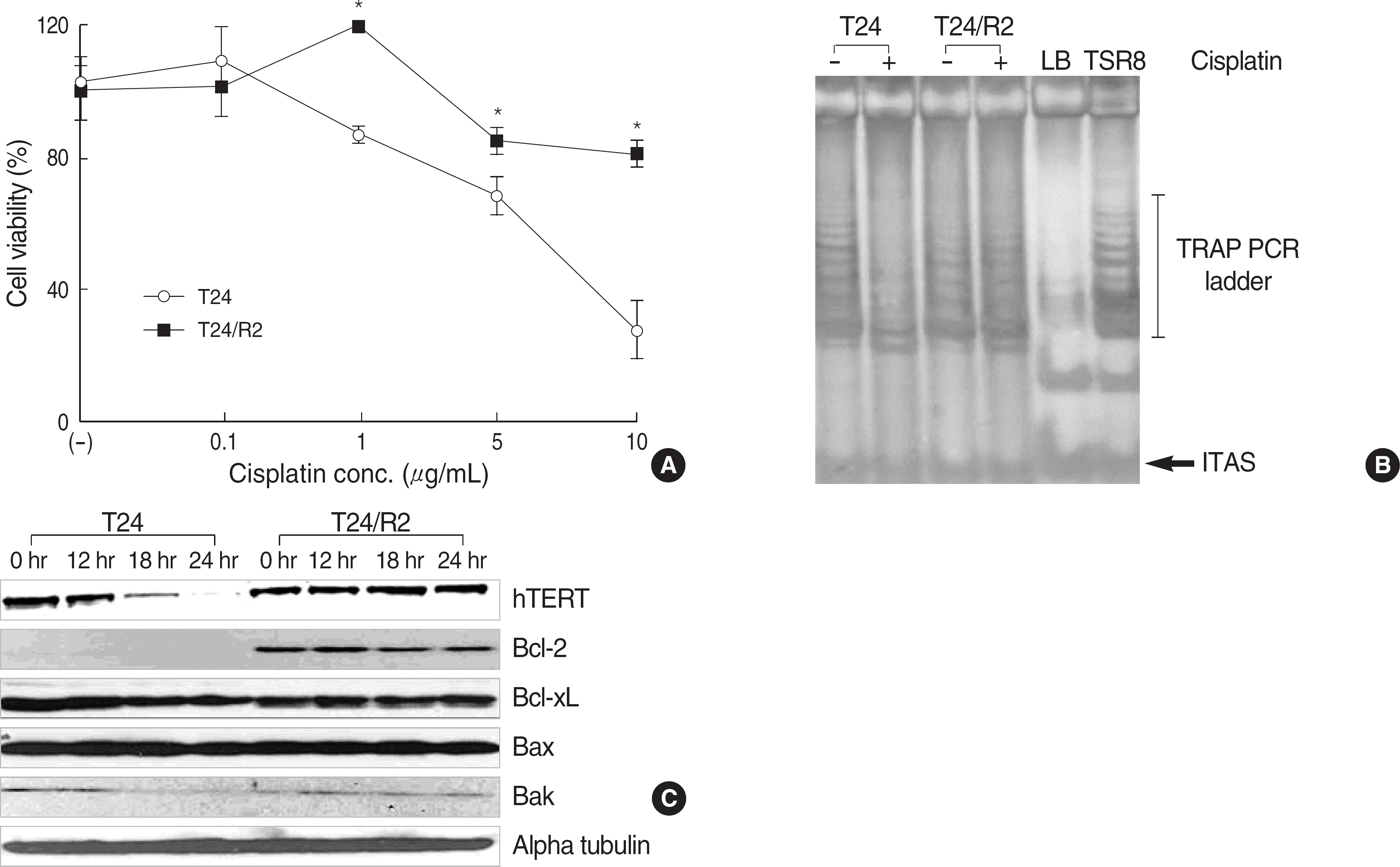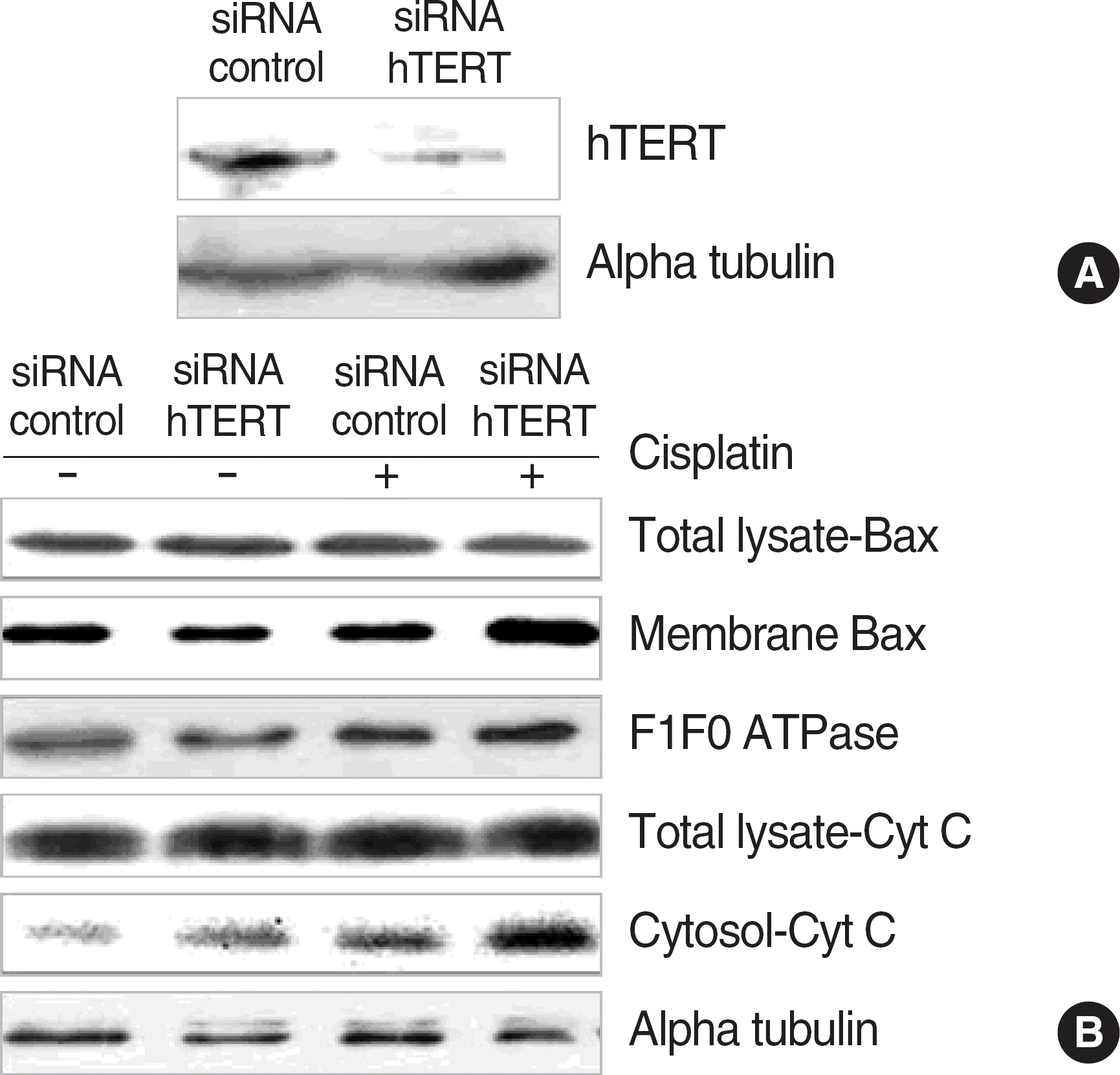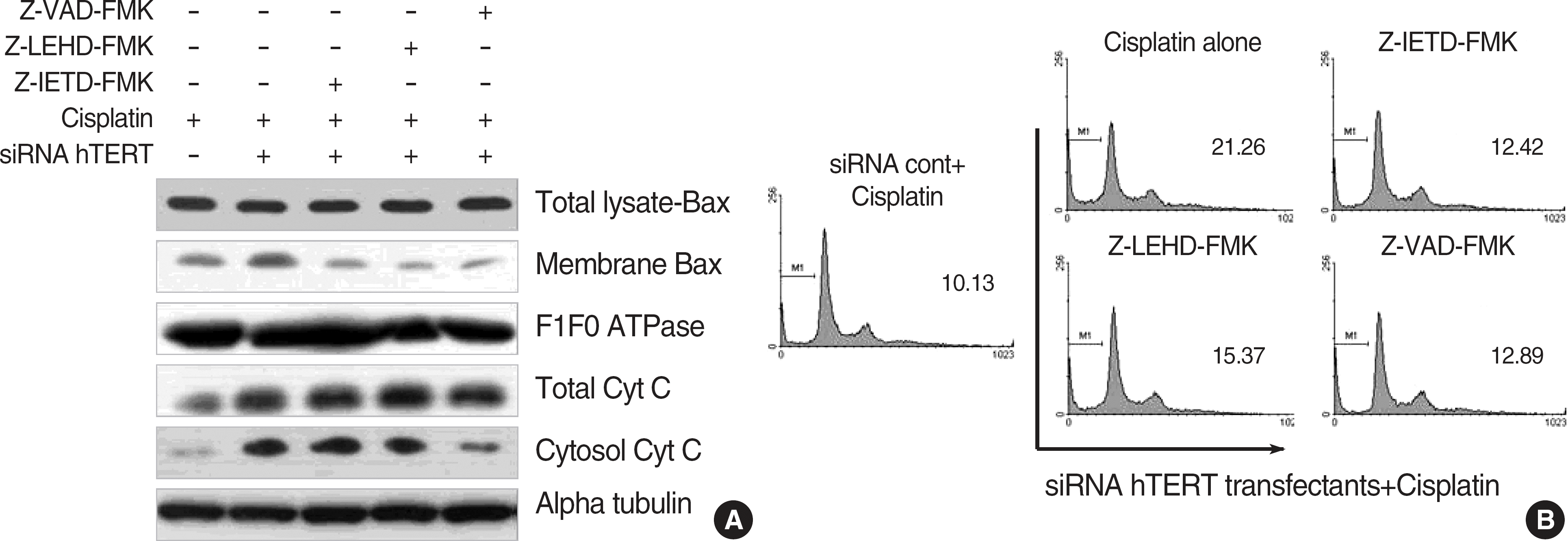Abstract
Background
Human telomerase reverse transcriptase (hTERT) is a catalytic enzyme that is required for telomerase activity (TA) and cancer progression. Telomerase inhibition or inactivation increases cellular sensitivity to UV irradiation, DNA-damaging agents, the tyrosine kinase inhibitor, imatinib, and pharmacological inhibitors, such as BIBR1532. hTERT is associated with apoptosis. Some patients show drug-resistance during anti-cancer drug treatment and the cancer cell acquire anti-apoptotic mechanism. Therefore, we attempted to study correlation between hTERT and drug-resistance.
Methods
To study the correlation between protein level and activity of hTERT and drug-resistance, Western blotting and telomerase repeat amplification protocol (TRAP) assays were performed. To investigate whether hTERT contributes to drug resistance in tumor cells, we transiently decreased hTERT levels using small interfering RNA (siRNA) in T24/R2 cells.
REFERENCES
1.Chu G. Cellular responses to cisplatin. The roles of DNA-binding proteins and DNA repair. J Biol Chem. 1994. 269:787–90.

2.Siddik ZH. Cisplatin: mode of cytotoxic action and molecular basis of resistance. Oncogene. 2003. 22:7265–79.

3.Roth BJ., Bajorin DF. Advanced bladder cancer: the need to identify new agents in the post-M-VAC (methotrexate, vinblastine, doxorubicin and cisplatin) world. J Urol. 1995. 153:894–900.
4.Ozols RF., Corden BJ., Jacob J., Wesley MN., Ostchega Y., Young RC. High-dose cisplatin in hypertonic saline. Ann Intern Med. 1984. 100:19–24.

5.Hagopian GS., Mills GB., Khokhar AR., Bast RC Jr., Siddik ZH. Expression of p53 in cisplatin-resistant ovarian cancer cell lines: modulation with the novel platinum analogue (1R, 2R-diaminocyclohexane)(trans-diacetato)(dichloro)-platinum(IV). Clin Cancer Res. 1999. 5:655–63.
6.Levy MZ., Allsopp RC., Futcher AB., Greider CW., Harley CB. Telomere end-replication problem and cell aging. J Mol Biol. 1992. 225:951–60.

7.Feng J., Funk WD., Wang SS., Weinrich SL., Avilion AA., Chiu CP, et al. The RNA component of human telomerase. Science. 1995. 269:1236–41.

8.Meyerson M., Counter CM., Eaton EN., Ellisen LW., Steiner P., Caddle SD, et al. hEST2, the putative human telomerase catalytic sub-unit gene, is up-regulated in tumor cells and during immortalization. Cell. 1997. 90:785–95.

9.Nakamura TM., Morin GB., Chapman KB., Weinrich SL., Andrews WH., Lingner J, et al. Telomerase catalytic subunit homologs from fission yeast and human. Science. 1997. 277:955–9.

10.Lingner J., Cech TR. Telomerase and chromosome end maintenance. Curr Opin Genet Dev. 1998. 8:226–32.

11.Nugent CI., Lundblad V. The telomerase reverse transcriptase: components and regulation. Genes Dev. 1998. 12:1073–85.
12.Bodnar AG., Ouellette M., Frolkis M., Holt SE., Chiu CP., Morin GB, et al. Extension of life-span by introduction of telomerase into normal human cells. Science. 1998. 279:349–52.

13.Muller M. Telomerase: its clinical relevance in the diagnosis of bladder cancer. Oncogene. 2002. 21:650–5.

14.Heine B., Hummel M., Muller M., Heicappell R., Miller K., Stein H. Non-radioactive measurement of telomerase activity in human bladder cancer, bladder washings, and in urine. J Pathol. 1998. 184:71–6.

15.Ito H., Kyo S., Kanaya T., Takakura M., Koshida K., Namiki M, et al. Detection of human telomerase reverse transcriptase messenger RNA in voided urine samples as a useful diagnostic tool for bladder cancer. Clin Cancer Res. 1998. 4:2807–10.
16.Dettlaff-Pokora A., Matuszewski M., Schlichtholz B. Telomerase activity in urine sediments as a tool for noninvasive detection of bladder cancer. Cancer Lett. 2005. 222:83–8.

17.Wong KK., Chang S., Weiler SR., Ganesan S., Chaudhuri J., Zhu C, et al. Telomere dysfunction impairs DNA repair and enhances sensitivity to ionizing radiation. Nat Genet. 2000. 26:85–8.

18.Chen Z., Koeneman KS., Corey DR. Consequences of telomerase inhibition and combination treatments for the proliferation of cancer cells. Cancer Res. 2003. 63:5917–25.
19.Tauchi T., Nakajima A., Sashida G., Shimamoto T., Ohyashiki JH., Abe K, et al. Inhibition of human telomerase enhances the effect of the tyrosine kinase inhibitor, imatinib, in BCR-ABL-positive leukemia cells. Clin Cancer Res. 2002. 8:3341–47.
20.Ward RJ., Autexier C. Pharmacological telomerase inhibition can sensitize drug-resistant and drug-sensitive cells to chemotherapeutic treatment. Mol Pharmacol. 2005. 68:779–86.

21.Lee ES., Min KJ., Kim SW., Lee HW., Cho KS., Kim KM, et al. Change of chemosensitivity and cellular characteristics of cisplatinum resistant human bladder cancer cells induced by long-term cisplatinum treatment. Korean J Urol. 1998. 39:305–10. (이은식, 민경준, 김수웅, 이해원, 조규선, 김광명 등. Cisplatinum 투여로 내성 유도된 방광암 세포주에서 항암제 감수성 및 세포학적 특성의 변화. 대한비뇨기과학회지 1998;39: 305-10.).
22.Kim JK., Kim KD., Lee E., Lim JS., Cho HJ., Yoon HK, et al. Up-regulation of Bfl-1/A1 via NF-kappaB activation in cisplatin-resistant human bladder cancer cell line. Cancer Lett. 2004. 212:61–70.
23.Cho HJ., Kim JK., Kim KD., Yoon HK., Cho MY., Park YP, et al. Upregulation of Bcl-2 is associated with cisplatin-resistance via inhibition of Bax translocation in human bladder cancer cells. Cancer Lett. 2006. 237:56–66.

25.Melissourgos N., Kastrinakis NG., Davilas I., Foukas P., Farmakis A., Lykourinas M. Detection of human telomerase reverse transcriptase mRNA in urine of patients with bladder cancer: evaluation of an emerging tumor marker. Urology. 2003. 62:362–7.

26.Zou L., Zhang P., Luo C., Tu Z. shRNA-targeted hTERT suppress cell proliferation of bladder cancer by inhibiting telomerase activity. Cancer Chemother Pharmacol. 2006. 57:328–34.

27.Herbert B., Pitts AE., Baker SI., Hamilton SE., Wright WE., Shay JW, et al. Inhibition of human telomerase in immortal human cells leads to progressive telomere shortening and cell death. Proc Natl Acad Sci U S A. 1999. 96:14276–81.

29.Hahn WC., Stewart SA., Brooks MW., York SG., Eaton E., Kurachi A, et al. Inhibition of telomerase limits the growth of human cancer cells. Nat Med. 1999. 5:1164–70.

30.Schindler A., Fiedler U., Meye A., Schmidt U., Fussel S., Pilarsky C, et al. Human telomerase reverse transcriptase antisense treatment downregulates the viability of prostate cancer cells in vitro. Int J Oncol. 2001. 19:25–30.

31.Damm K., Hemmann U., Garin-Chesa P., Hauel N., Kauffmann I., Priepke H, et al. A highly selective telomerase inhibitor limiting human cancer cell proliferation. EMBO J. 2001. 20:6958–68.

32.Kondo Y., Koga S., Komata T., Kondo S. Treatment of prostate cancer in vitro and in vivo with 2-5A-anti-telomerase RNA component. Oncogene. 2000. 19:2205–11.

33.Koga S., Kondo Y., Komata T., Kondo S. Treatment of bladder cancer cells in vitro and in vivo with 2-5A antisense telomerase RNA. Gene Ther. 2001. 8:654–8.

Fig. 1.
TA and hTERT expression in cisplatin-resistant T24/R2 cells. (A) T24 and T24/R2 cells were treated with cisplatin (0.1-10 μg/mL) for 24 hr. Cell cytotoxicity (%) was measured by an MTS assay. The optical density (OD) values are mean ±SD of triplicates. ∗, P<0.01 by t-test. (B) Exponentially growing T24 and T24/R2 cells were treated with 10 μg/mL of cisplatin for 24 hr. Telomerase activity was analyzed with a PCR-based TRAPeze kit (Intergen, Purchase, NY, USA) in the presence of cell extracts following the protocols provided by the manufacturer. (C) T24 and T24/R2 cells were treated with cisplatin (10 μg/mL) for the periods indicated. Forty μg aliquots of cell lysate were immunoblotted with anti-hTERT, bcl-2, bcl-xL, bax, bak, and alpha-tubulin antibodies.

Abbreviations: TA, telomerase activity; hTERT, human telomerase reverse transcriptase; TRAP, a polymerase chain reaction-based telomere repeat amplification protocol assay.
Fig. 2.
Effects of hTERT knock down on bax translocation and cytochrome C release. (A) T24/R2 cells were transfected with hTERT siRNA using Lipofectamine. After 24 hr, the cells were treated with cisplatin for an additional 24 hr and western blot analysis was performed. (B) T24/R2 cells transfected with hTERT siRNA were separated into cytosolic and membrane fractions. The extracts were subjected to 15% SDS-PAGE and immunoblotted with antibax, cytochrome C, F1F0 ATPase, and alpha-tubulin antibodies. Abbreviations: hTERT, See Fig. 1.

Fig. 3.
Caspase inhibitors block the effects of hTERT knock down in cisplatin-induced apoptosis of T24/R2 cells. (A) T24/R2 cells were transfected with hTERT siRNA and pre-treated with caspase inhibitors before cisplatin treatment. After further incubation for 24 hr, the cells were fractionated and the locations of Bax and cytochrome C were evaluated by western blotting. (B) Treatment as in (A). Cells were fixed with ethanol and stained with PI solution in the dark for 30 min. Apoptotic cell death was determined by flow cytometry. Abbreviations: hTERT, See Fig. 1; PI, propidium iodide.





 PDF
PDF ePub
ePub Citation
Citation Print
Print


 XML Download
XML Download